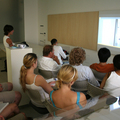Antonio Citterio
— interview with PR rep Alessandra Noto and Industrial Design Manager Toan Nguyen
About
Born in 1950 in Meda, Italy, Antonio Citterio holds a degree in architecture from Milan Polytechnic. In 1972, he opened up a studio focusing on industrial design, and later in 1981 started an architectural and interior design business. In 1999, Antonio Citterio and Partners, a multidisciplinary studio for architectural design, industrial design and graphics, was founded by Citterio and Patricia Viel. Patricia Viel is head of the architecture department and is also involved in the management of the company. Currently the studio headquarters is in Milan and there is also an office located in Hamburg, Germany.
Citterio's design work ranges from small to large scale projects in the areas of architecture, industrial design, furniture, and graphics. He has collaborated with many Italian and foreign companies such as B&B Italia, Flexform, Kartell, Flos, Arclinea, and Vitra.
Another aspect of Citterio's professional life is that he has also taught at a number of post-secondary institutions in Italy, including Domus Academy in Milan, Universita' la Sapienza in Rome and the Architecture Academy in Mendriso.
Antonio Citterio has received the prestigious Compasso d'Oro twice: in 1987 and 1995. Some of his designs are included in the permanent collections of notable museums such as MoMa in New York, the Pompidou in Paris and the Museum of Architecture and Design in Chicago.
— reference from http://www.antoniocitterioandpartners.it
Interview Ideas
Presentation
- Wide range of different products and projects that the company works on, from small scale (i.e. kitchen cutlery) to large scale (i.e. commercial buildings).
- Office studio tour. Each floor of the studio is a different department: Architecture, Industrial Design and Communications.
- The way that Citterio designs are not about big concepts and creating an art object, rather it is about practical uses involving the user in focus.
Main Ideas
- Idea of what to design is defined in collaboration with the client first. It may also come from experience, other times it is more complex and difficult, or it comes from market trends.
- Italy has had a unique design process and culture, where most designers have a background in architecture and also in product design. Today this has changed, as there is now a greater divide between the architecture and industrial design fields.
- The Citterio office has a mix of different design mediums, which allow collaboration and connections between them. It gives the opportunity for the exchange of ideas and knowledge that are needed for different projects.
- Design itself is an important focus in Italian design. Italian design is not purely about marketing but more about the design itself and the relationships a firm has with other companies.
- Italian design is design for the people.
- Approach to design includes the relationship with the client. Design, the user and technology are also factors.
Video/Key Quotes
- Italian design in the present and future

- Italy and China/Far East: Pressure in design and production

- Design process specific to Italy: architecture and design

- The change in the Italian design process

What We Learned
Antonio Citterio is a prime example of a traditional Italian designer; one who is educated as an architect but who also does industrial design, and designs at many different scales. It seems that in the present day there are fewer designers with this background, and architecture and industrial design are often separated. It was interesting to see one office that specializes as well as collaborates in different fields of design which is no longer very common in design studios. Citterio views collaboration as being important in design because it helps to create knowledge and experience, as well as a strong connection and interaction. This is important to the way his studio works and is apparent in the way the studio is laid out. For example, if they were to design a building for a client, they could also design the interior and the furnishings in the building, and to accomplish it, the different disciplines would need to communicate and collaborate on this project to keep it consistent on all levels.
We learned that time, experience, and knowledge are important factors in design. Knowledge and experience gained over time through different projects helps the company become better at designing certain products. Italian design is design for the person, which focuses on the user for everyday living, not for marketing or something you only see in magazines. This is what makes Italian design unique, along with their history, traditions, culture and craftsmanship.
The status of Italian design might change in the near future because there are factories being moved from Italy to locations in the Far East that have lower costs for production. In Italy, design, factories, and industry are connected, and the results of the factories moving may impact Italian design. There is pressure that is felt from the production ability that the Far East and China have. We don't know what to anticipate, but we know that it will take time to see what impact it will have globally and on Italy.
